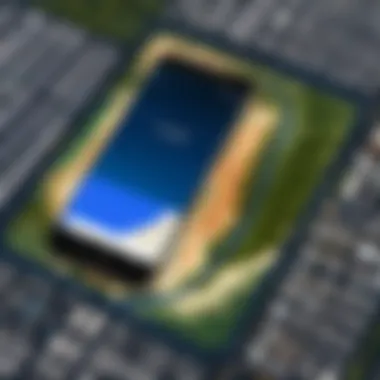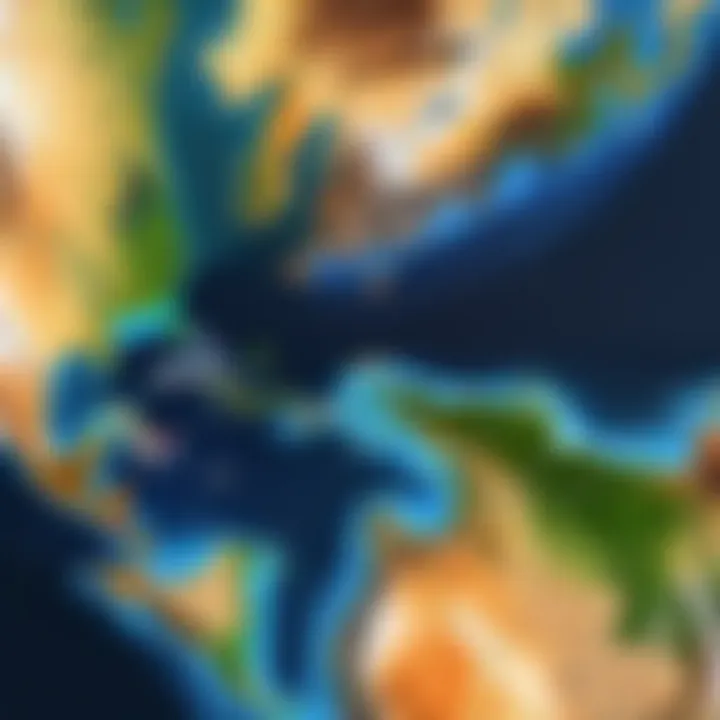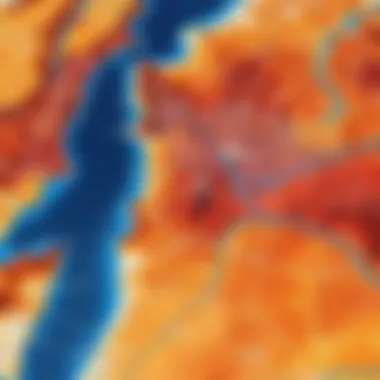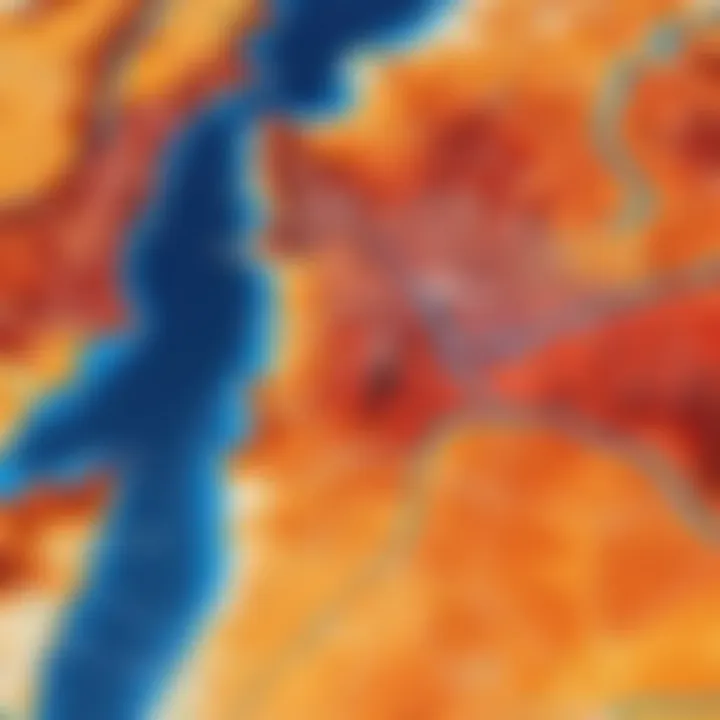Exploring Google Earth's Best Versions and Features


Intro
Google Earth has transformed how we visualize and understand our planet. Initially launched as a simple mapping tool, it has evolved into a multi-faceted platform rich in geographical data and interactive features. This article aims to delve into the best versions of Google Earth, highlighting its key functionalities, user experience, and practical applications. For professionals in various industries, understanding these features can maximize their utilization of this powerful geographic tool.
Overview of Core Features
Google Earth is packed with essential functionalities designed for various users. At its core, it offers satellite imagery, aerial photography, and GIS (Geographic Information Systems) data. These features enable users to explore locations around the globe in high detail.
Key functionalities include:
- 3D Terrain: View landscapes in three dimensions, helpful for urban planning or environmental assessments.
- Virtual Tours: Guided explorations of significant landmarks or natural wonders, enhancing educational and presentation experiences.
- Historical Imagery: Access to past satellite images, aiding researchers and historians in understanding geographic changes over time.
- Tools for Measurement: Accurately measure distances and areas, supporting tasks in fields like architecture or land surveying.
- Integration with Other Software: Sync with platforms like Google Drive for easy sharing and collaboration.
Comparison of features across top software options:
In contrasting Google Earth with other mapping tools, notable differences emerge.
- Google Earth vs. ArcGIS: While both provide mapping capabilities, ArcGIS excels in advanced analytics and GIS functionalities, appealing more to professionals in geography and urban planning.
- Google Earth vs. MapQuest: MapQuest remains user-friendly and good for quick directions, whereas Google Earth offers immersive experiences and varied geographical data.
- Google Earth vs. Bing Maps: Bing Maps provides similar imagery but lacks the comprehensive features and community contributions found in Google Earth.
User Experience and Interface
The user interface of Google Earth plays a crucial role in its effectiveness. With a polished interface, it allows for easy navigation between 2D maps and 3D views. Users can manipulate the globe simply by clicking and dragging, providing an intuitive experience.
Insights into UI/UX design aspects include:
- Search Functionality: Quick access to locations enhances user engagement and reduces frustration.
- Layered Information: Users can toggle different data layers, such as borders, photos, and terrain, to customize their viewing experience.
- Responsive Actions: Users can easily switch between flights, tours, and their own saved locations, streamlining workflows.
Importance of usability and accessibility:
A well-designed interface not only attracts users but also retains them. Google Earth’s accessibility features, including screen reader compatibility and keyboard shortcuts, make it inclusive for all. This focus on usability reflects a commitment to providing a tool that is not only powerful but also easy to navigate.
"In the rapidly evolving tech landscape, tools like Google Earth bridge the gap between complex data and user accessibility, making high-quality geographic information available to everyone."
Understanding the intricacies of Google Earth equips users with valuable insights, whether they are in research, development, or simply exploring the globe. As we continue with this article, further examination of the unique features and potential applications will empower professionals to make informed decisions in utilizing this versatile tool.
Prolusion to Google Earth
Google Earth is not just a software; it serves as a complex platform that bridges the gap between technology and the understanding of our planet. Its significance in today's world cannot be overstated. Google Earth allows users to visualize geographical data with remarkable detail. Whether for casual use or professional projects, this tool offers invaluable insights into both natural and built environments.
The Conceptual Framework
The conceptual framework of Google Earth hinges on satellite imagery and 3D mapping technology. This framework enables users to navigate worlds, from bustling cities to remote wilderness. It integrates Geographic Information Systems (GIS) to provide contextual overlays of data such as terrain, roads, and even weather patterns. The core concept revolves around the visualization of geographic data in an intuitive manner. This means users can easily interact with the data without requiring advanced technical skills. This accessibility is crucial for making informed decisions across various sectors, including urban planning, education, and environmental monitoring.
Purpose and Functionality
The primary purpose of Google Earth lies in its ability to make geographical data accessible and usable for a wide audience. It functions as a powerful tool for exploration and education. Users can zoom in on Earth from a global perspective down to specific neighborhoods. The functionalities extend beyond mere viewing; it allows for the measurement of distances, the assessment of land use, and the viewing of historical vistas, all seamlessly integrated into a user-friendly interface.
Key features include:
- Satellite Imagery: High-resolution images provide a clear view of different terrains.
- 3D Modeling: Users can visualize buildings and landscapes in three dimensions.
- Custom Overlays: Users can add their own data layers for specialized analyses.
With these functionalities, decision-makers can leverage Google Earth to conduct in-depth spatial analysis, assess environmental changes, and collaborate on projects. This article will delve deeper into its various iterations to help users maximize the potential of Google Earth.
Historical Overview of Google Earth
Understanding the historical context of Google Earth is crucial for comprehending its current capabilities and potential futures. The journey of this software illustrates the progression of geographic information systems (GIS) and how they have transformed accessibility and interaction with spatial data. A well-rounded grasp of its timeline reveals key shifts in technology and user expectations, which continue to shape its development. This section highlights significant phases in Google Earth’s evolution, emphasizing milestones that have contributed to its stature in the realm of digital mapping.
Initial Launch and Development
Google Earth was initially launched in 2005 as a product of Keyhole, a company specializing in geospatial data visualization. The acquisition of Keyhole by Google marked the beginning of what would become a revolutionary tool in mapping technology.
The original application, named Keyhole Earthviewer, offered users the ability to explore satellite imagery and delve into geographical features with relative ease. In 2005, Google branded it as Google Earth, expanding its reach and user base significantly. Immediately, the application allowed users to zoom from satellite view to street view, fostering a new way for individuals to connect with places and data.


The launch demonstrated a significant leap in user engagement metrics, as individuals could now access rich, interactive geographical data from their own homes. This understanding of spatial data accessibility laid the foundation for future innovations and updates.
Key Milestones and Updates
Through the years, Google Earth has undergone several crucial updates that enhanced its functionality and visual appeal. Each update brought forth features that not only improved user experience but also extended the software’s applications beyond casual use.
- 2006: Integration of Google Maps - With the introduction of user-generated content and various mapping layers, Google Earth became more interactive.
- 2008: 3D Building Technology - The incorporation of 3D building technology allowed users to explore urban landscapes in a more immersive way.
- 2012: Google Earth API – Supporting new developer capabilities, this API enabled third-party applications to utilize the core functionalities of Google Earth.
- 2017: New User Interface – A significant redesign aimed at simplifying navigation and enhancing user experience, making it more intuitive for first-time users.
"The continued evolution of Google Earth illustrates the dynamic nature of technology, reflecting advances in user interface and data visualization capabilities."
- 2020: Google Earth Web - A web-based version was released, allowing users to access its functionalities without needing to download software. This move represented a shift towards accessibility in a browser-centric world.
These updates showcase not just enhancements but also the adaptability of Google Earth to meet user needs. Each milestone reflects a response to feedback from a diverse user base, which often includes professionals in various fields such as urban planning, education, and environmental research.
In summary, the historical overview of Google Earth provides essential insights into its journey from a basic mapping tool to a multifaceted platform. Understanding the initial launch and key milestones enables users to appreciate the depth and breadth of features that Google Earth offers today.
Versions of Google Earth
Understanding the various versions of Google Earth is crucial for users who wish to utilize the software effectively. Each version offers distinct features, ensuring that users can select the one best suited for their needs. This section will delve into the desktop, mobile, and web-based options, highlighting their specific advantages and considerations.
Desktop Version Analysis
The desktop version of Google Earth remains one of the most comprehensive options available. It provides users with vast functionalities compared to its mobile and web counterparts. The interface is rich with features including terrain imaging, 3D building rendering, and historical imagery access. These capabilities make it a preferred choice for professionals working on demanding projects, such as urban design or geographic analysis.
Furthermore, the desktop version allows users to import various data layers, enabling sophisticated visualizations. This is particularly beneficial for architects and city planners who need to represent their projects in a real-world context. The ability to create and share personalized maps adds another layer of utility, ensuring users can collaborate effectively.
Mobile Applications Overview
Mobile applications for Google Earth bring geographic exploration to a more personal level. These versions typically provide a streamlined experience tailored for smaller screens. Engaging features like location tracking and the ability to explore Earth through touch gestures make it an appealing option for casual users.
However, mobile applications have limitations in comparison to the desktop version. Advanced tools for data manipulation are often absent, which can hinder professional applications. Despite this, the user-friendly interface and portability allow professionals to leverage Google Earth for fieldwork and presentations while on the go.
Web-Based Options
The web-based version of Google Earth functions directly from the browser, offering accessibility without the need for installation. This option has evolved significantly, featuring a user-friendly interface suitable for quick explorations and educational purposes.
Users can access basic functionalities like searching locations and viewing satellite imagery. However, it lacks some advanced features found in the desktop version, such as 3D visualization capabilities. That said, the web-based option is ideal for users needing immediate access to geographic data without the full feature set. This is particularly useful in classrooms where educators may want to demonstrate geographical concepts without significant set-up time.
"Each version of Google Earth accommodates unique user requirements, from comprehensive desktop applications to convenient mobile experiences."
Feature Comparison Across Versions
The comparison of features across different versions of Google Earth is essential for understanding its versatility and importance in various applications. Each version of the software offers distinct functionalities that cater to different user needs. By analyzing these features, professionals can identify which iteration best suits their projects or personal usage. This evaluation assists in making informed decisions, optimizing workflows, and enhancing productivity.
User Interface and Experience
The user interface (UI) of Google Earth significantly impacts user experience (UX). Different versions present varying UIs, which can affect how intuitively users navigate the software. The desktop version promotes a more immersive experience with larger screens, utilizing the full range of graphic capabilities of modern computers. Users appreciate features like easy navigation through 3D views, which enhance the exploration of global landscapes.
In contrast, mobile applications have tailored interfaces for smaller screens. These versions focus on simplified interactions, allowing quick access to essential functions like searching and viewing locations. However, some users find this simplicity limiting. Thus, balancing functionality and usability is key in UI design for all versions.
Data Visualization Capabilities
Data visualization is one of the cornerstone capabilities of Google Earth. This aspect varies notably between versions. The desktop version allows for extensive integration of GIS data and sophisticated visualizations. Users can import KML files, enabling the representation of detailed geographical information including terrain and demographic data. This makes it invaluable for analysts and researchers who need to present complex data visually.
On the other hand, mobile applications support basic visualization features, which can be sufficient for casual users. They provide essential data layers like weather or traffic overlays but may not support the depth of analysis possible on desktop. As the demands for data visualization grow, understanding these capabilities is crucial for users who rely heavily on spatial data.
Overlay and Customization Features
Customization is another significant aspect when comparing Google Earth versions. The desktop variant offers extensive overlay options, allowing users to superimpose various data sets onto existing basemaps. This includes drawing paths, adding markers, and incorporating third-party data sources. The customization options suit professionals in fields like urban planning and environmental science, enabling them to create detailed contextual analyses.
In contrast, mobile versions have limited customization features. While they may allow some basic overlays, the complexity and range of options are reduced. This difference may mean that for detailed work, professionals might lean towards the desktop version as their primary tool. Understanding these distinctions can guide professionals in selecting the appropriate version based on the level of customization they require.
Overall, assessing the features within Google Earth's various iterations helps users select the right tool for their specific applications and environments.


User Experiences and Feedback
Understanding user experiences and feedback is crucial when evaluating Google Earth. The software serves a wide array of users, from casual explorers to professional researchers. By examining these experiences, one can identify strengths and weaknesses, guiding potential users in their selection process. Feedback can illuminate features that users value most, such as detailed satellite imagery, user-friendly navigation, and robust data visualization tools.
Professional Use Cases
In professional circles, Google Earth is employed in various sectors, significantly enriching workflows. For instance, urban planners use the platform to visualize land use, helping them in making informed decisions regarding development. The layering feature allows for comprehensive spatial insights, integrating demographic data or environmental studies. Construction professionals utilize Google Earth to assess site conditions and zoning laws.
Additionally, architects find value in the software for planning projects in context with existing terrain and structures. Environmental scientists rely on Google Earth for monitoring changes in ecosystems and land cover. The capability to overlay important information as well as access historical data further enhances its utility.
Anecdotal Evaluations
Anecdotal feedback provides a lens into the practical usage of Google Earth from a personal perspective. Users often share experiences related to their specific needs or intentions. Some might highlight how the measuring tool assists them in planning vacations, while others appreciate discovering points of interest that enhance their travels. The customization options available also garner positive remarks; users enjoy personalizing their maps for different purposes.
Stories from educators reveal the effectiveness of Google Earth in classroom settings. Teachers use it to engage students in geography lessons, turning abstract concepts into relatable visuals. Meanwhile, many nature enthusiasts describe it as an inspirational tool, as it offers the ability to explore remote locations without physical travel.
"The richness of geographic information found in Google Earth simplifies complex topics for students, leaving a lasting impact on their understanding of the planet."
These anecdotes reveal not just functionality but emotional connections where users find joy or utility in the tool. Understanding these perspectives also assists developers in addressing concerns and refining features to match user expectations.
Geographic Data Accuracy
Geographic data accuracy is fundamental to the effectiveness of any mapping software, including Google Earth. This aspect ensures that users can trust the visual and spatial information presented, which is crucial for applications in various sectors like urban planning, environmental monitoring, and education. The integrity of this data influences not only user decisions but also the overall success of projects relying on geographic insights.
Accurate geographic data provides several benefits. It enhances decision-making processes for professionals, allows for precise planning and execution of projects, and supports effective communication among teams. Moreover, the accuracy of such data affects the credibility of the analysis derived from it, making it a paramount factor for users who need reliable information.
However, there are considerations to keep in mind regarding geographic data accuracy. First, data can become outdated. Geographic boundaries, road systems, and land use patterns change over time. Therefore, users must ensure they are using the most current data available through updates or direct sources. Second, different users may require varying degrees of precision. While some professionals may need high-resolution data for detailed analysis, others may find basic geographic outlines sufficient for their needs.
In summary, geographic data accuracy is essential in the context of Google Earth as it significantly impacts usability across different fields. Understanding its implications creates reassurance about the software's reliability in professional settings.
Technical Framework for Geographic Data
The technical framework supporting geographic data in Google Earth involves complex systems that incorporate satellite imagery, aerial photography, and GIS applications. Google Earth utilizes high-resolution imagery collected from satellite systems, which is continuously processed to provide a comprehensive view of Earth from different angles. This data underpins the rendering of geographical features, terrains, and urban landscapes, ensuring visual fidelity for developers and users alike.
The integration of geographic information systems is also critical. These systems allow users to analyze spatial data and extract meaningful insights. Data layers can be added to Google Earth, providing context to the imagery and enabling users to visualize specific information, such as population density, zoning laws, or environmental data. This multifaceted approach allows for advanced analytical capabilities, enhancing user interaction and engagement with the software.
Comparative Accuracy with Other Software
When comparing Google Earth's geographic data accuracy to other software, it is vital to consider the sources and methods of data collection. Competitors like ArcGIS and QGIS also offer robust mapping solutions but diverge in their approaches and capabilities.
- Imagery Sources: Google Earth primarily uses satellite imagery from its proprietary satellites and partnerships with other space agencies. In contrast, ArcGIS may rely on a broader spectrum of data sources, including government databases and community input, which can provide localized accuracy.
- Data Resolution: Google Earth excels in providing high-resolution imagery for urban areas. However, in remote or rural locations, its data may not always match the detail offered by specialized software like ArcGIS, which serves particular professional sectors, such as environmental science and land management.
- Update Frequency: Google Earth is known for its user-friendly interface and regularly updated content. However, other platforms may offer prioritized updates for critical datasets, ensuring that professionals have access to the latest changes in real-time.
Understanding these differences is crucial for users who seek precise geographical representations. Each software has its strengths, but the choice greatly depends on specific needs and the context of usage.
Potential Applications in Professional Settings
The effectiveness of Google Earth extends beyond recreational uses; its capabilities can significantly enhance professional settings. The tool offers powerful geographic insights that aid in diverse sectors, including urban planning, environmental research, and education. Understanding these applications is essential for decision-makers and professionals who aim to utilize geographic data for strategic purposes.
One key benefit of Google Earth is its ability to integrate complex data layers. Professionals can visualize topographic and demographic information simultaneously, making analysis more efficient. Moreover, users can apply customization options to tailor their views to specific projects. This flexibility results in better assessments and decisions.
When exploring the professional applications of Google Earth, it is important to consider the following elements:
- Accessibility of comprehensive geographic data.
- The user-friendly interface that simplifies navigation through layers of information.
- The potential for collaboration among teams using shared maps and projects.
Whether for urban development or environmental monitoring, Google Earth's adaptability serves various professional needs.
Urban Planning and Development
Urban planners find immense value in Google Earth. The software allows them to visualize land use patterns and track urban sprawl effectively. By analyzing satellite imagery, planners can assess existing infrastructure and make informed forecasts for future developments. This is crucial when deciding where to allocate resources for new projects or renovations.
Additionally, Google Earth provides tools for simulation. For example, planners can project how new buildings impact surrounding areas or how a new road will alter traffic flow. This ability to simulate scenarios supports data-driven decision-making.
Benefits of Using Google Earth for Urban Planning:


- Access to high-resolution imagery that improves spatial awareness.
- Tools for measuring distances and areas for feasibility studies.
- Enhanced communication with stakeholders through visual representations.
Environmental Research and Monitoring
In the field of environmental research, Google Earth is a valuable asset. It enables scientists and researchers to track changes in land cover, deforestation, and climate impacts over time. Researchers can use historical imagery to analyze how specific regions have changed, contributing to a deeper understanding of environmental trends.
Moreover, Google Earth's layer options allow users to overlay specific data, such as pollution levels or wildlife habitats. This capability makes it easier to visualize the effects of environmental policies and initiatives. Overall, Google Earth facilitates a more comprehensive approach to environmental analysis.
Educational Purposes
Educational institutions utilize Google Earth as a teaching resource across various subjects. For geography, it provides a visual context that enhances student comprehension of world locations and physical features. In science classes, students can explore ecosystems, climate zones, and geological formations interactively.
By incorporating Google Earth into lessons, educators can engage students more effectively. They can use the software to take virtual field trips, allowing students to experience locations they may never visit in person.
Advantages of Google Earth in Education:
- Interactive learning experiences that promote student engagement.
- Tools for creating customized projects that encourage critical thinking.
- Access to a wealth of data that supports interdisciplinary learning.
By leveraging the potential applications of Google Earth, professionals can foster collaboration, improve decision-making, and promote a greater understanding of complex geographic phenomena.
Future Developments in Google Earth
The exploration of future developments in Google Earth is critical, not only to understand its trajectory but also to inform users about advancements that could enhance functionality and usage versatility. As technology evolves, the integration of newer tools and capabilities enhances the software’s efficiency for professional and personal users alike. Future developments can significantly impact user experience by streamlining processes, improving data accuracy, and increasing engagement with geographical information.
Emerging Technologies
Emerging technologies hold the potential to redefine how users interact with Google Earth. These advancements may include integration with artificial intelligence, which can enhance data analysis and visualization, making complex information more accessible. For instance, machine learning algorithms could predict urban development patterns based on historical data and trends.
Virtual reality (VR) is another innovation that can transform the way users experience geographical data. By immersing users in a 3D environment, Google Earth can provide a deeper understanding of the terrain and geography. This technology may also cater to educational purposes, allowing students and professionals to explore various landscapes interactively, promoting better learning.
In terms of environmental monitoring, integration with Internet of Things (IoT) devices could offer real-time data for more accurate geographical insights. Smart sensors deployed in various locations can feed live data into Google Earth, making it an invaluable tool for urban planners and environmental researchers.
User-Requested Features
Google Earth has a history of evolving based on user feedback, and continuing this approach is paramount for future success. By focusing on user-requested features, developers can ensure that the software remains relevant and effectively meets user needs. For example, many users have expressed the desire for enhanced offline capabilities. This would allow professionals working in remote areas to access crucial data without any internet connection.
Another common request is for improved collaboration tools. Enableing users to easily share and annotate maps could facilitate team projects in urban planning, conservation efforts, and research. Simplifying the sharing process would encourage community involvement and foster collaboration, critical for complex projects that rely on multiple stakeholders.
Additionally, incorporating a wider array of customizable interface options would benefit many users. Adjusting display settings—such as theme color or layout preferences—would allow professionals to organize information in a manner that suits their working style, improving productivity.
Emphasizing these user-led developments not only increases satisfaction but also fosters a loyal user base keen on contributing to the platform's community.
"By listening to users, Google Earth can remain a leader in geographical analysis and visualization."
Focusing on these emerging technologies and user-requested features can ensure that Google Earth continues to be an indispensable tool for a variety of professionals, ultimately solidifying its importance in the digital landscape.
Closure and Recommendations
The significance of the conclusion and recommendations section in this article cannot be overstated. By summarizing the insights provided throughout the various discussions, this section brings clarity and focus to the reader's journey through Google Earth's vast landscape. Key elements such as user experiences, feature evaluations, and geographic data accuracy culminate in a tailored final judgment, ensuring that industry professionals can make informed choices.
The benefits of concluding with solid recommendations are multifaceted. For starters, it synthesizes all relevant information from previous sections, allowing readers to see the bigger picture without getting lost in the details. This comprehensive overview can aid decision-makers when selecting the most suitable version of Google Earth for their unique needs.
Moreover, by addressing specific considerations, such as the intended use—whether it's environmental research, urban planning, or educational contexts—this section empowers professionals to align their technological tools with their objectives. The clarity of guidance offered here strengthens the overall utility of this article, ensuring readers leave with not just knowledge but actionable steps.
Best Practices for Use
To maximize the effectiveness of Google Earth, users should consider several best practices:
- Stay Updated: Regularly check for updates. Google Earth frequently releases enhancements that can improve functionality.
- Utilize Layers Wisely: Take advantage of Google Earth's various layers to visualize data that is relevant to your work. You can toggle inputs depending on which geographical features are necessary for your analysis.
- Explore Tools: Familiarize yourself with all available tools, whether on the desktop version or mobile applications. This can significantly enhance your user experience and allow for more precise data analysis.
- Leverage Community Resources: Engaging with forums like Reddit can provide new insights or recommendations based on practical usage from people in similar fields.
Final Thoughts on Selecting the Right Version
Choosing the right version of Google Earth depends on several critical factors. The variety of options presents advantages and limitations, making it vital to evaluate personal or organizational needs. Here are some considerations:
- Purpose of Use: Identify the specific goals for which you need Google Earth. For instance, if high-quality visualization and extensive features are paramount, the desktop version may be your best choice.
- Mobility Requirements: Assess whether a mobile application can cater to your needs while on the go. Google Earth on mobile offers unique features suitable for fieldwork.
- Connectivity Options: Depending on internet availability, a web-based option could serve well if high-end processing is less of a concern.
"Choosing the right version of Google Earth can dramatically influence your productivity and outcomes. Align your choice with your professional needs."
Ultimately, equipping oneself with the right version tailored to specific requirements is essential for optimizing performance while using this sophisticated tool.



